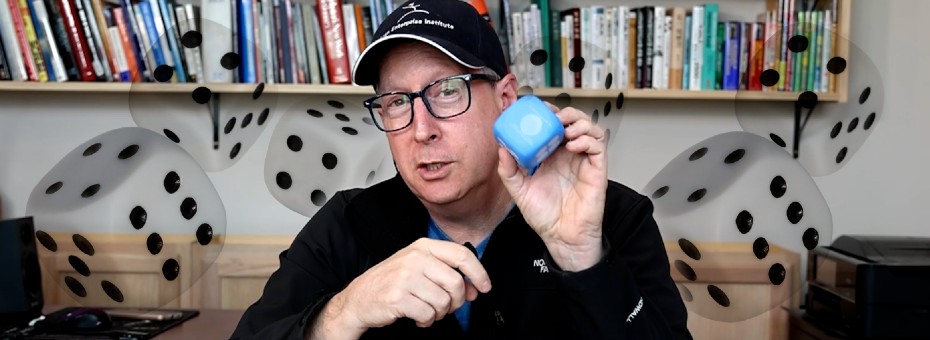Art Smalley is back with a brand new series on problem-solving. The first part sees Art explaining his lean background and the pitfalls of any “one-size-fits-all” approach to problem-solving. Find a transcript for part 1 below.
Hi everyone. This is Art Smalley, President of Art of Lean, Incorporated. Today, on behalf of the Lean Enterprise Institute, I want to bring you another short video. This one’s on the topic of problem-solving and specifically, coaching problem-solving. I think this is a very important topic. So, if it interests you, stick around, I think you’ll enjoy it.
Looking at the Factors
Now, in terms of introducing this topic, I’m going to start with a question. Why does it take so long to solve a given problem or improve a given situation? It does vary, right? Sometimes you do it in hours, sometimes in days, weeks, and sometimes months. Bigger transformations take even longer than that, but let’s keep this centered solely on the topic of specific problems and solving those. Now, I think it depends. The answer is not easy. I’m going to say there are three internal factors: types, scale, and complexity. There are also three external factors: urgency, leadership, and external noise.
That governs the equation that I want to explain those to you in this video. Now, before I dive in, my background is varied. It’s quite diversified. I’m happy to talk with you at length on this topic, but be forewarned, I can go deep and I can go broad. I love to talk about Toyota coaching practices because I speak, read, and write Japanese. I also worked in Japan for a decade in my life. I’ve been an internal director of improvement, an external change agent, and a consultant working in the biggest, hardest, and toughest situations. There are interesting companies out there. I’ve worked in small ones. I’ve also worked in national laboratories for 15 years. I’ve worked with distinguished scientists, serving certain types of problems and our national laboratory system, real scientists, not the so-called lean guys out there quoting science.
I also have talked extensively with people in the Marshall and the special forces community about the difference between generalist versus specialist. The specialists who are the 38-year-olds, high IQ, having multiple degrees, types of languages,and backgrounds. Also, I have a degree background in martial arts. It’s quite varied. In addition, I’ve had a pretty strong, lifelong interest in coaching and sports, whether it be track golf, football, or kids basketball. So, I’m really interested in this topic and come at it from different angles, not just the Toyota one, which might surprise you. Now, back to why it takes so long to solve a problem. Well, my simple answer is that it depends, but I think it depends upon the three internal and external things that I talked about, which you can’t really control, but certainly affect you.
Facing the Problems
These are what I call the types of problems, right out of my book, Four Types of Problems. I don’t think it’s a one-size-fits-all solution, space, or world. You can’t apply the same pattern or methodology in every case. If you do, you’ll get wildly different results. Also, I think it depends upon the difficulty of that problem. I’ll gladly go into some really difficult Toyota problems that were solved and are fair game to talk about, along with the experts behind them. They didn’t use five-why or A3 reports or Dematic or 8D. It’s quite interesting. Also, I’m gonna talk about skill and will level. I think it goes back to management, it’s organizational behavior and recognizing there’s situational leadership, things that come into play and you can’t address every team and every situation the same way. If you do, you’re going to struggle and frustrate the team.
There’s urgency and leadership, things that are outside the team’s control. Noise, customers, suppliers, outside parties in the company, I’ll bring in their thoughts to bear on the situation and they can help you. Sometimes they can be a force of friction and slow you down. It all depends. Now I have a minor in mathematics and whenever I’m stuck, I try and put things into either a mental model or a framework of a basic equation, just so I can think about it and start to realize I’m probably missing some things. But if I were to frame this as the equation, I’d say, well, when was I first asked the question of what’s the lead time to solve a problem? I’d say that dependent variable was a function of, at a minimum, X, Y, and Z; there’s more to it.
X represents your types, Y represents your complexity levels, and Z represents the skill will levels associated. Then you’ve got those other factors, a few influencing you in factoring in as well. Urgency, leadership, and noise. They all come to bear. All of the things I see in the lean community floating around for coaching are fine and they’re not wrong. The problem is, I think, and even these six that I’m talking about only address one side of the cube at a time, it’s fine to have types. You like a type or a favorite type, but it doesn’t work in all situations. It’s fine to go after easy, medium, or hard cases, but you can’t treat them the same and the same with skill and will levels. One size doesn’t fit all. You start having to deal with different types of cases, even with my simple X, Y, and Z analogy.
On top of that, you get urgency leadership and noise, but my point is good. Coaching frameworks have to consider all of that at a minimum. I think more advanced cases can be made where you think about things in addition to that as well, but at a minimum, we have to start ease. This is where I’m just dissatisfied with the current state. I don’t think you can say that humble inquiry is coaching and leave it at that. I don’t think you can just say, well, break it down to steps, key points, and reasons why and tell them how to do it. That’s the way to go after problem-solving. I also think there’s a huge limit to invoking martial art phrases. The ones being used in lean are not wrong, they’re well-intended. But, they’re often on the strange tangent and not even doing what actually is done in martial arts. They sure as heck are not science.
A Matrix of Possibilities
You know, when you come down and look closely at it, I think it is a company problem space, and I want to reopen our ability to talk about it because even with the cube, you’ve got a matrix. It’s not just the six sides. You’ve got combinations, permutations, and spaces inside the cube. If I take just my four types, the complexity levels, three complexity levels, and four skill and will levels, you get a lot more than just six situations to think about, and then factor in the urgency, the leadership, and the noise in the equation. It gets complicated, but I think we can frame it. I think the point is that we need to come up with a better framework and better way of thinking about the matrix. So we can come up with better solution spaces and just get past this one size fit all, or my pet way of doing things based upon steps or questions.
That’s where I think the game is being played right now and it’s not going well, at least in my opinion, watching the situation unfold. So, for the next series of videos, I’m going to stay on this topic for probably a couple months, for eight-to-ten videos, and go through what I consider the variables and external factors that we have to at least consider. Initially, there are more external examples that are not Toyota. I want to talk about some Toyota examples, go into some complex things that don’t use five-why, A3 reports, or the simple steps you’ve been taught. Look at open frameworks, which hopefully makes us consider other other points of view. Lastly, my end result is that somebody out there comes with a better, more unified coaching theory or framework for what we do in the lean world of problem-solving. So, I don’t think we’re there and I’m frustrated, but I know clients out there who come to me with questions and they’re frustrated, confused by the current state of this topic. So, let’s see what we can do thinking out loud together and come up with a better framework in the end.
Part one of eight. Watch the others:
- Part two, Lessons from NBA Coaches
- Part three, Lessons from Martial Arts
- Part four, Military Science and Leadership
- Part five, Tuckman’s Model of Team Formation
- Part six, Team-Building Tools and Practices
- Part seven, Dreyfus Model and the Stages of Learning
- Part eight, Toyota Coaching Practices
Problem Framing Skills
Improve your ability to break down problems into their specific, actionable parts.






